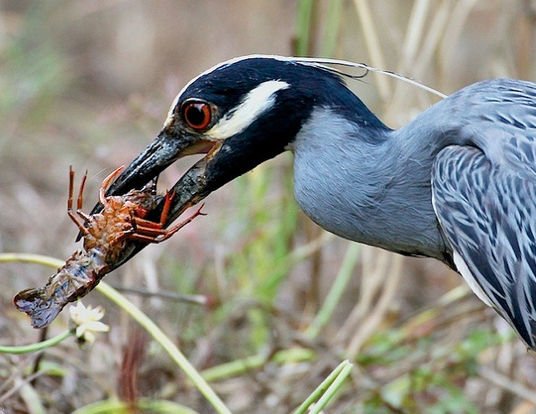Interactions
 The yellow-crowned night heron lives in unique and interesting
habitats, and in these habitats it interacts with various other
species. The yellow-crowned night heron is both nocturnal and
crepuscular feeding mostly at night. While feeding they most
commonly use the stand and wait method, where the heron waits
for prey to approach while standing motionless in or near the
water (Kushlan 1976).
The yellow-crowned night heron lives in unique and interesting
habitats, and in these habitats it interacts with various other
species. The yellow-crowned night heron is both nocturnal and
crepuscular feeding mostly at night. While feeding they most
commonly use the stand and wait method, where the heron waits
for prey to approach while standing motionless in or near the
water (Kushlan 1976).
The other method used is the walk slowly method, where the heron
slowly stalks the prey then strikes when it comes close enough
(Kushlan 1976; Meyericks 1960). In this hunting strategy, the
heron will usually swallow the crab whole; if the organism is
too large, they will shake the crab until its limbs are severed
and small enough to swallow (Wingate 1982).
In a study of the niche overlap between the scarlet ibis and the
yellow-crowned night heron, it was seen that in most areas they
inhabit, like mangrove swamps, they are the only carcinophagus (or crab eating) birds
(Martinez 2004). These
swamps are dominated by various trees such as the Red
Mangrove (Rhizophora mangle), in which the
yellow-crowned night heron may nest.
 Yellow-crowned night herons differ from other waterbirds in that
they specialize in preying on insects and crabs (Willard 1977). They most
commonly feed on mangrove land crabs such as Ucides cordatus,
Goniopsis cruentata as well as Aratus pisonii;
yellow-crowned night heron also consume blue, ghost, and fiddler crabs. Other
crabs consumed by the yellow-crowned night heron have been
studied in past student websites, such as Cancer magister (Dungeness
Crab), Cancer productus (Red
Rock Crab), and Chionoecetes opilio (Snow
Crab). Other than consuming crabs, night heron have also been
known to hunt crayfish and insects (Martinez 2004; Watts
1995).
Yellow-crowned night herons differ from other waterbirds in that
they specialize in preying on insects and crabs (Willard 1977). They most
commonly feed on mangrove land crabs such as Ucides cordatus,
Goniopsis cruentata as well as Aratus pisonii;
yellow-crowned night heron also consume blue, ghost, and fiddler crabs. Other
crabs consumed by the yellow-crowned night heron have been
studied in past student websites, such as Cancer magister (Dungeness
Crab), Cancer productus (Red
Rock Crab), and Chionoecetes opilio (Snow
Crab). Other than consuming crabs, night heron have also been
known to hunt crayfish and insects (Martinez 2004; Watts
1995).
Yellow-crowned night herons are mostly stenophagous, feeding on
a limited variety of foods (Kushlan 1976). This species of
waterbirds actively selects for larger crabs and are skilled
hunters (Laubhan et al. 1991). Herons are not particularly
social birds, they typically hunt individually usually
maintaining a 15 foot distance between others (Payne and Risley
1976). Continue onto the next page for more
interesting facts
about Nyctanassa violacea.